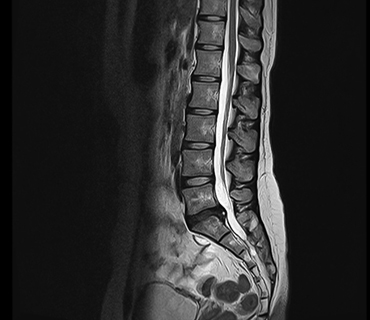Lumbar Spinal Stenosis
Lumbar Spinal Stenosis

The lumbar spine (lower back) consists of five vertebrae in the lower part of the spine between the ribs and the pelvis. Lumbar spinal stenosis is a narrowing of the spinal canal that compresses the nerves traveling through the lower back into the legs. While it may affect younger patients due to developmental causes, it is more often a degenerative condition that affects people after middle age and older. The discs may become less spongy as you age, resulting in reduced disc height and bulging of the hardened disc into the spinal canal. Lumbar spinal stenosis may or may not produce symptoms, depending on the severity of your case. The narrowing of the spinal canal itself does not produce these symptoms. It is the inflammation of the nerves due to increased pressure that may cause noticeable symptoms to occur. When present, symptoms may include:
- Pain, weakness, or numbness in the legs, calves, or buttocks
- Pain radiating into one or both thighs and legs, similar to sciatica
- In rare cases, loss of motor functioning of the legs
- In rare cases, loss of normal bowel or bladder function
Pain may decrease when you bend forward, sit or lie down. Pain may get worse when you walk short distances.
Degenerative spondylolisthesis and degenerative scoliosis (curvature of the spine) are two conditions associated with lumbar spinal stenosis. Degenerative spondylolisthesis (slippage of one vertebra over another) is caused by osteoarthritis of the facet joints. Most commonly, it involves the L4 slipping over the L5 vertebra. It usually is treated with the same conservative and surgical methods as lumbar spinal stenosis.
Degenerative scoliosis occurs most frequently in the lower back and more commonly affects people age 65 and older. Back pain associated with degenerative scoliosis usually begins gradually and is linked with activity. The curvature of the spine in this form of scoliosis often is relatively minor, so surgery is required when conservative methods fail to alleviate pain associated with the condition.
Diagnosis: Made by a neuro doctor based on your history, symptoms, a physical examination and test results, including the following:
- X-ray: Application of radiation to produce a film or picture of a part of the body can show the structure of the vertebrae and the outline of the joints.
- Magnetic resonance imaging (MRI): A diagnostic test that produces 3-D images of body structures using powerful magnets and computer technology; can show the spinal cord, nerve roots, and surrounding areas, as well as enlargement, degeneration, and tumors.
Medical treatment:
- Anti-inflammatory medications to reduce swelling and pain, and analgesics to relieve pain. Most pain can be treated with nonprescription medications, but if your pain is severe or persistent, your doctor may recommend prescription medications.
- Epidural injections of cortisone may be prescribed to help reduce swelling. This treatment is not recommended repeatedly and usually provides only temporary pain relief.
- Physiotherapy and/or prescribed exercises may help stabilize your spine, build your endurance and increase your flexibility. Therapy may help you resume your normal lifestyle and activities.
Doctor may recommend surgery if conservative treatment fails and medications do not reduce or end the pain altogether. He will talk to you about the types of spinal surgery available and, depending on your specific case, will help to determine what procedure might be an appropriate treatment for you. As with any surgery, a patient’s age, overall health and other issues are taken into consideration when surgery is considered.
You may be considered a candidate for spinal surgery if:
- Back and leg pain limits normal activity or impairs your quality of life
- You develop progressive neurological deficits, such as leg weakness and/or numbness
- You experience loss of normal bowel and bladder functions
- You have difficulty standing or walking
- Medication and physical therapy are ineffective
- You are in reasonably good health
There are several different surgical procedures that can be utilized, the choice of which is influenced by the severity of your case. In a small percentage of patients, spinal instability may require that spinal fusion be performed — this decision generally is determined prior to surgery. Spinal fusion is an operation that creates a solid union between two or more vertebrae. This procedure may assist in strengthening and stabilizing the spine, and may thereby help to alleviate severe and chronic back pain.
Surgical treatment :
The most common surgery in the lumbar spine is called decompressive laminectomy, in which the laminae (roof) of the vertebrae are removed to create more space for the nerves. A neurosurgeon may perform a laminectomy with or without fusing vertebrae or removing part of a disc. A spinal fusion with or without spinal instrumentation may be recommended when spondylolisthesis or scoliosis. Various devices (such as screws or rods) may be used to enhance fusion and support unstable areas of the spine.
The benefits of surgery are there and a large percentage of lumbar spinal stenosis patients report significant pain relief after surgery.
